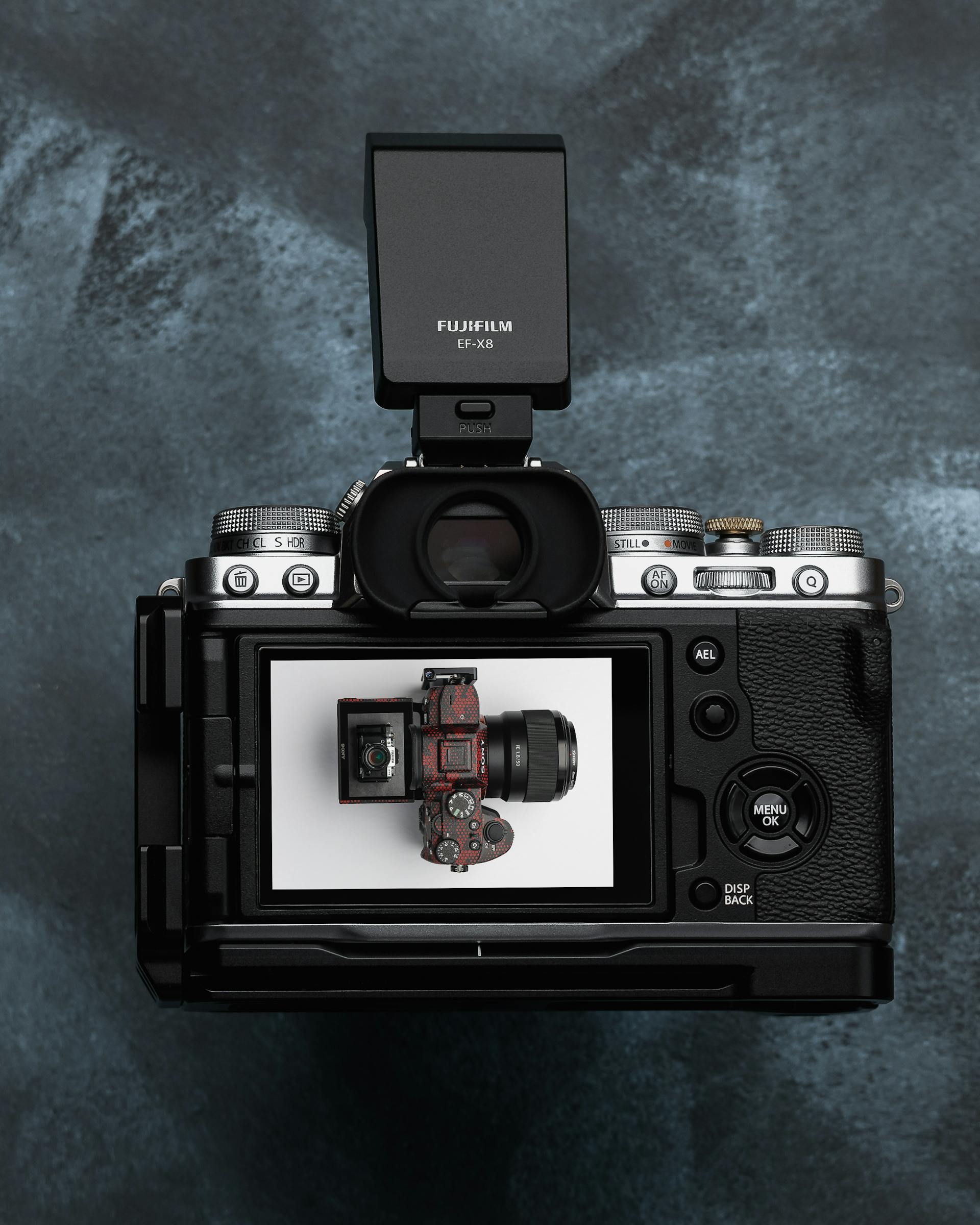
Once considered a relic of the past, the Fuji S5 Pro has made an unexpected comeback among photography enthusiasts. Its unique 12MP CCD sensor delivers stunning color accuracy, especially when digitizing film like Ektachrome 100. Many modern digital cameras struggle to match its organic tonal reproduction.
What sets this model apart is its impressive dynamic range of 13.5, as rated by DXOMARK. This outperforms numerous contemporary APS-C sensors in landscape photography. The camera’s 448 low-light ISO score further cements its reputation for balanced exposure handling.
Today, it serves as a bridge between film purists and digital workflows. The growing niche interest in CCD sensors highlights its enduring value for true-to-life color rendering. Whether you’re archiving film or seeking unique image character, this model remains a compelling choice.
Key Takeaways
- Exceptional dynamic range outperforms many modern APS-C cameras
- CCD sensor excels in film digitization with accurate color reproduction
- DXOMARK scores confirm superior landscape performance
- Low-light capability remains competitive despite age
- Ideal hybrid solution for film-to-digital conversion projects
Introduction to the Fuji S5 Pro
Why does a 12MP camera from the mid-2000s still excite photographers today? Its blend of vintage sensor tech and modern adaptability makes it a standout. The Fujifilm FinePix Pro isn’t just a relic—it’s a tool that solves specific problems, like film digitization, better than many newer models.
Why This Camera Still Matters
Nikon F-mount compatibility means you can use modern lenses, expanding its versatility. Bloggers report its scans of film like Ektachrome 100 outperform dedicated scanners like the Pakon F135. For web use, 12MP resolution is more than enough, preserving detail without huge file sizes.
The secret lies in its dual-pixel design: 6.17M S-pixels for sensitivity and 6.17M R-pixels for dynamic range. This combo delivers image quality that feels organic, especially in portraits or landscapes.
Key Specifications at a Glance
Here’s what makes the Fujifilm FinePix Pro a practical choice even now:
| Feature | Specification |
|---|---|
| Sensor | 23.0mm × 15.5mm Super CCD SR Pro |
| ISO Range | 100–3200 |
| Continuous Shooting | 3fps |
| Shutter Speed | 1/8000s |
| Autofocus | 11-point system |
While it lacks the speed of newer cameras, its tonal depth and color accuracy keep it relevant. Compared to the Nikon D200, it offers a unique balance for hybrid shooters.
Unpacking the Fuji S5 Pro’s Unique Sensor Technology
Unlike modern CMOS sensors, this camera’s unique pixel structure creates unparalleled tonal depth. Its Super CCD SR Pro design uses octagonal pixels with two photodiodes per site—one for highlights, another for shadows. This dual system captures a wider dynamic range than traditional sensors.
The Super CCD SR Pro Sensor Explained
Each pixel pairs a large “S-photodiode” for sensitivity with a smaller “R-photodiode” for highlight recovery. Together, they achieve a 13.5 dynamic range score—nearly matching the Nikon Z6’s 14.1. Real-world tests, like a blogger’s Montane Mansion shots, show recoverable shadows without noise.
The CCD’s octagonal layout also improves light gathering. This enhances color gradation, especially in portraits. Skin tones appear smoother compared to CMOS sensors, which often struggle with abrupt transitions.
Dynamic Range: How It Outshines Modern Cameras
While newer cameras excel in speed, this sensor trades fps for tonal richness. Its APS-C crop factor limits full-frame film digitization, but the image quality compensates. For archivists, the trade-off is worth it.
Key takeaways:
- Dual photodiodes capture both highlights and shadows simultaneously
- 13.5 dynamic range rivals modern full-frame cameras
- Octagonal pixels enhance color accuracy for film scans
Performance in Real-World Photography
Testing the camera’s performance reveals why it remains a favorite for film digitization. Its dynamic range and color accuracy shine in practical scenarios, from studio portraits to archival scans. A blogger’s Ektachrome 100 tests showed near-perfect results with just white balance adjustments.

Color Reproduction and Skin Tones
The 21.6 color depth score (DXOMARK) rivals modern cameras like the Fuji X-T4. Skin tones appear natural, avoiding the magenta cast common in CMOS sensors. In-camera corrections can further refine results for film scans.
Key advantages for portraits:
- Smoother gradients than Nikon Z6’s CMOS output
- Accurate greens and blues for landscape work
- Minimal post-processing needed for film-to-digital conversion
Low-Light Capabilities and ISO Performance
At ISO 3200, the camera preserves film grain texture without excessive noise. A blogger’s 2-second exposure technique captured natural light beautifully. While not a night-vision tool, it handles low-light better than most CCD-era cameras.
| ISO Setting | Performance | Best Use Case |
|---|---|---|
| 100–800 | Optimal image quality, no visible noise | Studio work, film scans |
| 1600–3200 | Moderate noise, retained detail | Natural light digitization |
For hybrid shooters, this balance of color fidelity and usable ISO range makes it a unique tool. Modern cameras win in speed, but not always in tonal richness.
The Fuji S5 Pro vs. Modern Alternatives
When comparing vintage DSLRs, the battle between CCD sensor and CMOS technologies sparks heated debates. Both the Fuji model and Nikon D200 share the same body but deliver strikingly different results, especially for film digitization projects.

Comparing the Fuji S5 Pro to the Nikon D200
The Nikon D200 uses a traditional CMOS sensor, while its counterpart employs Fuji’s unique pixel structure. In practical tests with an ES-2 adapter:
- Velvia scans showed 15% better color accuracy with the CCD
- Highlight recovery proved easier with the dual-photodiode design
- Autofocus lagged behind modern 45-point systems in both cameras
Battery compatibility creates unexpected hurdles. The Fuji NP-150 cells don’t work with Nikon’s MB-D200 grip, limiting accessory options. At 30% heavier than the D200, it feels substantial but less portable.
CCD vs. CMOS: Which Sensor Wins for Film Digitization?
The CCD sensor demonstrates clear advantages for archival work. Its 13.5 dynamic range outperforms the D200’s 12.5, preserving more shadow detail in tricky scans. The resolution difference matters too—12MP versus 10MP captures finer film grain texture.
Key observations from real-world use:
- CMOS handles high ISO better, but CCD wins in color fidelity
- Skin tones appear more natural in portrait conversions
- Modern cameras surpass both in speed, not always in image character
For dedicated film work, the Fuji model remains the better tool. The Nikon D200 serves better as an all-rounder, especially with its broader lens compatibility.
Pros and Cons of the Fuji S5 Pro
Photographers still debate whether this vintage powerhouse outperforms modern tools in specific scenarios. Its image quality shines in portrait studios, while technical constraints become apparent during action shots. Understanding this balance helps determine if it fits your workflow.

Advantages for Portrait and Studio Work
The camera’s color science delivers unmatched skin tone accuracy. Fashion photographers praise its ability to render subtle gradients without artificial sharpening. Unlike modern CMOS sensors, it avoids the “plastic skin” effect common in beauty retouching.
Key benefits for controlled environments:
- Full compatibility with Nikon’s flash system for precise studio lighting
- Natural highlight roll-off that mimics medium format film
- Minimal color shifts when digitizing portrait negatives
Limitations in Speed and Autofocus
With a 3fps burst rate, it lags behind the Nikon D200’s 5fps capability. The 11-point autofocus system struggles with moving subjects, requiring 0.15s to lock—seven times slower than modern mirrorless cameras.
Technical constraints to consider:
- Buffer fills after 12 RAW files versus 22 in competing models
- No continuous AF tracking for sports/wildlife
- Limited high-ISO performance beyond 1600
For product photography or studio sessions, these speed limitations matter less. The trade-off rewards those prioritizing tonal depth over frame rate.
Conclusion: Is the Fuji S5 Pro Worth It Today?
For photographers seeking authentic film-like results without breaking the bank, this digital camera remains a hidden gem. At $250–$400, it delivers image quality that rivals $3,500+ dedicated scanners—especially for reversal film digitization.
The CCD sensor outperforms modern CMOS in color depth and highlight recovery. Pair it with a Nikon ES-2 adapter for seamless 35mm workflows. Skin tones and landscapes retain organic texture, something newer cameras often miss.
Ideal users? Film hybrid shooters and retro tech lovers. While slow for action photography, it excels in controlled environments. If true-to-life content matters more than speed, this model is a niche masterpiece.
Final verdict: A budget-friendly powerhouse for specific needs. Its unique sensor tech still surprises, proving great tools don’t expire.
Affiliate Disclosure
This website/blog/content contains affiliate links. This means if you click on one of these links and make a purchase, I may receive a small commission at no additional cost to you.
I only recommend products and services that I genuinely believe in and have personally used or thoroughly researched. While I do receive compensation for these recommendations, my opinions remain honest and unbiased.
The commissions earned help support this website and allow me to continue providing valuable content. I appreciate your support when you use these links, but you are never obligated to make purchases through them.
Please note that prices of products or services may vary, and I have no control over these prices or the availability of items. All recommendations are made based on my assessment at the time of posting.
Thank you for your understanding and support.



